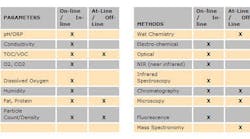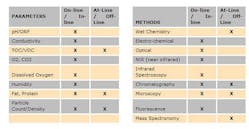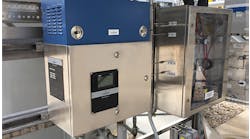In the process, batch and hybrid industries, deviations in product quality often take time to identify. The longer it takes to identify an off-spec product, the more costly the problem will be in time, raw materials, quality giveaway, waste and energy. It is critical to be able to accurately measure and control both process variables (pressure, level, flow, temperature, etc.) and product quality parameters. In cases where unmeasured disturbances are present, model predictive control techniques can be employed to manipulate the process conditions to maintain consistent product quality.
While these approaches are well-established within the refining and petrochemical processing industries, in recent years the U.S. Food and Drug Administration (FDA) recognized the value of this type of science-based quality control, which it refers to as Process Analytical Technologies (PAT), in the typically batch-style processing industries that it regulates.
Today, fast, accurate and reliable analysis of raw materials, work in process and finished product quality analysis are critical in both continuous and batch process manufacturing industries and will become even more important in Europe and elsewhere as Industry 4.0-type imperatives gain increased traction.
Analytical Measurement Approaches
Ideally, chemical composition or other product quality parameters should be made with a frequency and an accuracy high enough to enable automated feedback control. Generally speaking, the closer to the process these measurements can be executed, the less time passes between sampling, testing and results; and the faster operators can react to unwanted deviations. These measurements need to be executed without interrupting the process or increasing the risk of false alarms.
Source ARC Advisory Group
Analysis approaches can be classified by many criteria, variables to measure, measurement methods or even the placement of the analyzer. All these aspects are interlinked. Different categories include off-line lab analysis, at-line analysis, and on-line/in-line analysis.
Off-Line Lab Analysis
Historically, property and composition measurements for feedstocks, work in process or finished products were executed on product samples in dedicated laboratories after being collected manually from the process and brought back to the laboratory for conditioning and analysis. Skilled personnel in a clean, well-equipped lab environment can conduct a full range of measurements with high accuracy and reliability. The results allow the most comprehensive analysis of the quality and composition of the product and its compliance to applicable standards.
However, off-line analysis only reflects the specific conditions at the time of the sampling. Since lab measurements don’t provide information about the actual live process, they cannot be utilized directly for real-time control. However, off-line techniques are still valuable for analysis that cannot be performed using other methods to complement and calibrate inferential or virtual measurements.
At-Line Analysis
Automated analytical devices allow some measurements to be moved closer to the process. While most of the sampling is still done manually, the analysis can be executed on the plant floor by less-skilled personnel, thus freeing laboratory time and allowing for faster and more frequent results for certain chemical compositions or product characteristics. The devices offer the option to analyze several samples at the same time. The physical proximity to the live process saves time compared to laboratory analysis, but collecting and transporting samples still involves a time delay.
On-Line and In-Line Process Analysis
Off-line and at-line analysis might be the only practical option for certain complex parameters. Yet for many measurements, suppliers offer a variety of on-line process analyzers that minimize or even eliminate the time delays, yet provide appropriate accuracy and repeatability.
On-line analyzers combine automatic sampling with direct access to automated measuring devices, bringing analysis right next to the process. In some cases, the on-line analyzers take product samples through a bypass directly from the flow. This method allows a whole range of results to be available in close to real time; delayed only by the time it takes the device to take the sample, prepare it if necessary, and execute the corresponding measurements. This method is also often more cost-efficient as the automated systems lower the need for highly skilled laboratory staff.
In-line analysis, in contrast, integrates analyzers right into the process flow without requiring a bypass and the resulting additional complexity. However, only a limited number of parameters can be measured in this manner and the analyzer can’t be allowed to interrupt or contaminate the process.
While measurements obtained from off-line and at-line analyzers often require manual intervention to deliver value, real-time on-line and in-line chemical composition and product quality analysis measurements can be incorporated into control loops to support closed-loop process control and, by extension, closed-loop product quality control. Real-time analysis can also be used to support MPC or plantwide optimization.
Benefits of Real-time Process Analysis
Just as accurate and reliable process variable measurements are critical for good process control, accurate chemical composition and other product quality measurements are critical for companies across a wide variety of process industries. While the required frequency of measurements will vary based on the process time dynamics, faster is often better.
Off-line lab measurements can take hours or even days to complete, and at-line measurements can consume precious minutes; but in-line and on-line analyzers typically provide analysis measurements in real time or near-real time. This enables operators and control systems to respond quickly to measurements that are varying from established parameters to minimize product rework, waste and quality giveaway; and increase flexibility by reducing the time it takes to start up processes, make product grade transitions or switch product recipes.
Limitations
As with most sophisticated technologies, technical and financial limitations apply when implementing real-time process analysis. While the number of technologies and corresponding analytical measurements that have moved from the laboratory to the plant floor and into the process is growing; not all compounds and mixtures can be analyzed in real time or near real-time. And even when the technology is available, installing these systems comes at a price.
Integrating the analyzers and analysis results into real-time optimization schemes could help take users to the next level, but also involve additional integration, model building and support costs. It’s also important to consider the benefits and drawbacks associated with performing these types of advanced applications in the DCS or in a separate platform.
Finally, it’s critical to recognize that without reliable methods and systems in place to maintain and periodically calibrate analyzers (ideally in an automated manner), their value will quickly degrade to nil.



